
Home & Commercial fruit and nut growers rely upon the Grow N’ Guide to cultivate healthier and more productive trees in their orchards through several years of development.
The Grow N’ Guide was designed for ease of use and systematically modifies the manner in how growers train their young fruit or nut trees within the first five years, offering numerous benefits in subsequent years.
Benefits of training your tree at planting:
- Trees bear fruit/nuts earlier, with increased size
- Develops a strong branch structure that can support the increased weight of fruit/nuts and ice/snow during winter months
- Requires only moderate annual pruning when it reaches bearing age
- Prevents the squandering of time and funds needed to replant the tree in the event it has fallen victim to disease or insect infestations; or due to the excess weight from crop load/ice and snow damage


The Grow N’ Guide’s channel system positions the stem and the branch to fit the curvature
of the horizontal and vertical arm, preventing them from rotating outward.
When training the trees in an orchard, the importance of how much light is intercepted by the stem will dictate how productive it will be, with concerns of yield, size and quality in future years.
The influence of light distribution through out the tree underlines the importance of training the scaffold/lateral branches to an angle that the stem can receive the light as evenly around the tree as possible.
Light affects numerous physiological developments in the tree being its foundation of energy, fundamentally creating a dependence of that light. The energy from sunlight is applied to manufacture sugars, thus producing considerable amounts of dry materials for the growth of leaves, branches, roots and mast (fruits/nuts)
Limb Training:
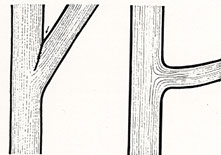 To increase the amount of light in reaching the stem and penetrate the canopy, the positioning will determine whether how much vegetative growth or fruiting will occur. The ideal limb position is 60-90 degrees from the stem, creating the ideal crotch angle. This angle establishes more than just light interception to the stem, thus dramatically increases the strength of the branch to withhold the added weight of fruit/nut crops and ice/snow during the winter months.
To increase the amount of light in reaching the stem and penetrate the canopy, the positioning will determine whether how much vegetative growth or fruiting will occur. The ideal limb position is 60-90 degrees from the stem, creating the ideal crotch angle. This angle establishes more than just light interception to the stem, thus dramatically increases the strength of the branch to withhold the added weight of fruit/nut crops and ice/snow during the winter months.
By attaching the vertical portion of the Grow N’ Guide to the stem of the tree and the horizontal section atop the branch, the Grow N’ Guide would be positioned by sliding it downward to where it would create the 60-90 degree angle from the stem.
Branch crotches having very narrow angles of attachment at the stem fails to develop outward and is absorbed by the growth of the branch and trunk. In ensuing years, additional bark is enclosed within the crotch. This condition is referred to as “included bark” which has long been associated with the weakness in tree crotches within a broad range of various species and types of trees. The included bark prevents the formation of connecting wood between the stem and branch, thus reducing overall crotch strength.
Tree on (L) illustrates a bark inclusion of a poorly trained tree. Tree on (R) demonstrates a properly trained tree when first planted.
The strength of tree crotches is due to the annual development of overlaying trunk and branch tissues at the base and the sides of the crotch. As the tree grows, the trunk branch union is buried more deeply within the trunk and the strength of the attachment dramatically increases.
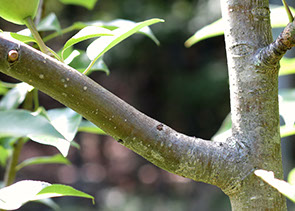
The Grow N' Guide was instrumental in trailing this Pear Tree from the day it was planted.


Training greatly affects the development and spatial positioning of shoots,
which in turn significantly affects light interception by fruiting shoots.
The underside of the Grow N’ Guide demonstrates, by what method, the branch is trained when joining the stem.
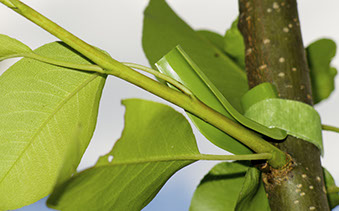
Due to the flexibility of the young shoot from the main stem, it is easily trained and forced to grow outwards, thus creating a wide crotch angle for increased light interception. The lack of strength prevents the branch from pushing upwards and effortlessly follows the channel of the guide.
The Ice/Snow Dilemma.
The accumulation of sticking ice/snow during winter storms can make tree branches more than double in weight,
while at the same time, add stress to their weak points.
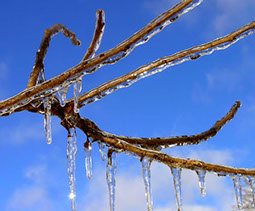
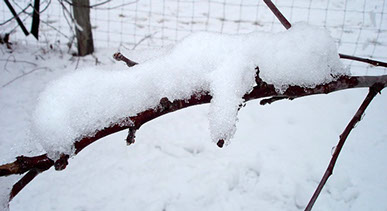
The following spring, harmful insects and disease can gain a foothold from such damage and cause the loss of the entire tree,
thus endangering the remaining trees in the orchard.
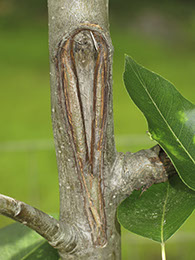
Collars from around the base of branches help them remain attached to the trunk, however if the collar forms improperly or is
lacking, then branches may not be well secured to the trunk thus causing them to split from the trunk rather easily.
Structural strength of a branch union is based on the development of a branch collar where the annual growth rings of the trunk overlap the annual growth rings of the side branch. As the branch collar develops, side branch tissues connect into the trunk in a wedge shape, making for a structurally strong branch union. For the branch collar to develop, the diameter of the side branch must be less than half the diameter of the trunk.
With the introduction of the Grow N’ Guide to the horticulture market, fruit and nut growers across North America are able to properly train their trees for optimal health, production and structural strength, for the life of the tree.
Copyright Innovative Creations 2014
U.S. Patent #8,943,747